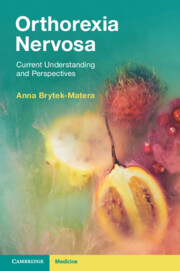70 results
Chapter 5 - Electrical Aspects
-
- Book:
- Wind Turbines
- Published online:
- 24 January 2025
- Print publication:
- 19 December 2024, pp 88-117
-
- Chapter
- Export citation
Characteristics of effective design support: insights from evaluating additive manufacturing design artefacts
-
- Journal:
- Design Science / Volume 10 / 2024
- Published online by Cambridge University Press:
- 02 December 2024, e38
-
- Article
-
- You have access
- Open access
- HTML
- Export citation

Orthorexia Nervosa
- Current Understanding and Perspectives
-
- Published online:
- 30 October 2024
- Print publication:
- 07 November 2024
2 - Adult Dyslexia
- from Part I
-
- Book:
- Succeeding and Adult Dyslexia
- Published online:
- 11 January 2024
- Print publication:
- 01 February 2024, pp 25-58
-
- Chapter
- Export citation
COVID-19 second wave and clinical characteristics of cases in Uganda: A retrospective cross-sectional survey of confirmed SARS-CoV-2 cases, March–June 2021
-
- Journal:
- Epidemiology & Infection / Volume 151 / 2023
- Published online by Cambridge University Press:
- 25 July 2023, e142
-
- Article
-
- You have access
- Open access
- HTML
- Export citation
The characteristics of bipolar dipression
-
- Journal:
- European Psychiatry / Volume 65 / Issue S1 / June 2022
- Published online by Cambridge University Press:
- 01 September 2022, p. S555
-
- Article
-
- You have access
- Open access
- Export citation
WHAT MOTIVATES AND DISCOURAGES DESIGNERS TO USE DIGITAL SKETCHING? COMPARING ITS USE TO EXTERNALISE IDEAS VERSUS COMMUNICATING WITH EXTERNAL STAKEHOLDERS
-
- Journal:
- Proceedings of the Design Society / Volume 1 / August 2021
- Published online by Cambridge University Press:
- 27 July 2021, pp. 3441-3450
-
- Article
-
- You have access
- Open access
- Export citation
Preface
-
- Book:
- Dynamics of Multiphase Flows
- Published online:
- 10 September 2021
- Print publication:
- 17 June 2021, pp xix-xxvi
-
- Chapter
- Export citation
Clinical Characteristics and Abnormal Parameters Evolution in Patients With Novel Coronavirus Infection: A Case Series of 272 Cases in Guangzhou
-
- Journal:
- Disaster Medicine and Public Health Preparedness / Volume 16 / Issue 6 / December 2022
- Published online by Cambridge University Press:
- 18 May 2021, pp. 2492-2498
-
- Article
-
- You have access
- Open access
- HTML
- Export citation
Characteristics of 1738 Patients With Coronavirus Disease 2019 (COVID-19) in Wuhan, China
-
- Journal:
- Disaster Medicine and Public Health Preparedness / Volume 16 / Issue 6 / December 2022
- Published online by Cambridge University Press:
- 30 April 2021, pp. 2453-2457
-
- Article
-
- You have access
- Open access
- HTML
- Export citation
5 - Article 10(1) Berne: The Meaning of Quotation
-
- Book:
- Global Mandatory Fair Use
- Published online:
- 26 October 2020
- Print publication:
- 05 November 2020, pp 83-139
-
- Chapter
- Export citation
What distinguishes positive deviance (PD) health professionals from their peers and what impact does a PD intervention have on behaviour change: a cross-sectional study of infection control and prevention in three Israeli hospitals
-
- Journal:
- Epidemiology & Infection / Volume 148 / 2020
- Published online by Cambridge University Press:
- 14 October 2020, e259
-
- Article
-
- You have access
- Open access
- HTML
- Export citation
Place matters: government capacity, community characteristics, and social capital across United States counties
-
- Journal:
- Journal of Public Policy / Volume 41 / Issue 4 / December 2021
- Published online by Cambridge University Press:
- 10 September 2020, pp. 677-705
-
- Article
- Export citation
1 - Understanding Artificial Intelligence
-
- Book:
- The Reasonable Robot
- Published online:
- 15 June 2020
- Print publication:
- 25 June 2020, pp 18-35
-
- Chapter
- Export citation
P02-106 - Ascertainment of Individual Specifications of Addicts Admitted to Tehran Treatment Centers
-
- Journal:
- European Psychiatry / Volume 25 / Issue S1 / 2010
- Published online by Cambridge University Press:
- 17 April 2020, 25-E704
-
- Article
-
- You have access
- Export citation
13 - The power of play to engage and nurture creative, independent learners
- from Part III - Teaching and learning in HASS
-
- Book:
- Making Humanities and Social Sciences Come Alive
- Published online:
- 15 March 2019
- Print publication:
- 14 February 2019, pp 228-246
-
- Chapter
- Export citation
The mitochondrial genome of Dipetalonema gracile from a squirrel monkey in China
-
- Journal:
- Journal of Helminthology / Volume 94 / 2020
- Published online by Cambridge University Press:
- 17 October 2018, e1
-
- Article
-
- You have access
- HTML
- Export citation
10 - Leading teams, coaching and mentoring
-
- Book:
- Leadership
- Published online:
- 16 April 2019
- Print publication:
- 17 September 2018, pp 254-279
-
- Chapter
- Export citation
School Psychology and Supervision in Australia
-
- Journal:
- The Educational and Developmental Psychologist / Volume 35 / Issue 1 / July 2018
- Published online by Cambridge University Press:
- 26 April 2018, pp. 1-17
- Print publication:
- July 2018
-
- Article
- Export citation
Characterisation of vitamin and mineral supplement users differentiated according to their motives for using supplements: results of the German National Nutrition Monitoring (NEMONIT)
-
- Journal:
- Public Health Nutrition / Volume 20 / Issue 12 / August 2017
- Published online by Cambridge University Press:
- 20 June 2017, pp. 2173-2182
-
- Article
-
- You have access
- Open access
- HTML
- Export citation

